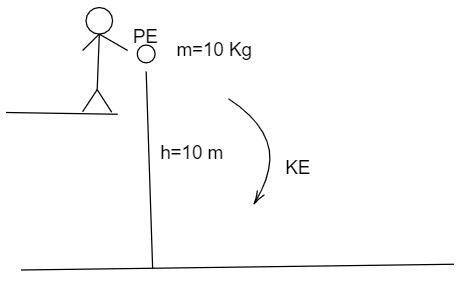Answer
64.8k+ views
Hint: Use the formula of the potential energy, substitute all known values to find the answer. Use the law of conservation of energy to find the kinetic energy from potential energy. Substitute the kinetic energy value in its formula to find the velocity formula.
Formula used:
(1) The potential energy is given by
$PE = mgh$
Where $PE$ is the potential energy of the ball, $m$ is the mass of the ball, $g$ is the acceleration due to gravity and $h$ is the height at which the object is placed from the earth surface.
(b) The formula of the kinetic energy is
$KE = \dfrac{1}{2}m{V^2}$
Where $KE$ is the kinetic energy while the ball falling down, $m$ is the mass if the ball and $V$ is the velocity of the ball.
Complete step by step solution:
It is given that the
Mass of the ball, $m = 10\,Kg$

Height at which the ball is dropped, $h = 10\,m$
(a) By using the formula of the potential energy,
$PE = mgh$
Substitute the value of the acceleration due to gravity as $9.81$ .
$PE = 10 \times 10 \times 9.81$
By the further simplification of the above step,
$PE = 980\,J$
(b) According to the law of the conservation of the energy, the total energy always remains constant. That is the amount of energy before falling is equal to the total energy after falling.
$PE = KE$
Hence $KE = 980\,J$
(c) The formula of the kinetic energy is
$KE = \dfrac{1}{2}m{V^2}$
Substitute the values of the mass and the kinetic energy in it.
$980 = \dfrac{1}{2} \times 10 \times {V^2}$
By simplifying the above equation,
${V^2} = \dfrac{{980 \times 2}}{{10}}$
By further simplification,
${V^2} = 196\,m{s^{ - 1}}$
$V = 14\,m{s^{ - 1}}$
Thus, the option (D) is correct.
Note: In this question, the potential energy of the ball is calculated before the ball is dropped. The kinetic energy of the ball is calculated when the ball drops down with some kinetic energy in it. These both are equal in this case, based on laws of conservation of energy.
Formula used:
(1) The potential energy is given by
$PE = mgh$
Where $PE$ is the potential energy of the ball, $m$ is the mass of the ball, $g$ is the acceleration due to gravity and $h$ is the height at which the object is placed from the earth surface.
(b) The formula of the kinetic energy is
$KE = \dfrac{1}{2}m{V^2}$
Where $KE$ is the kinetic energy while the ball falling down, $m$ is the mass if the ball and $V$ is the velocity of the ball.
Complete step by step solution:
It is given that the
Mass of the ball, $m = 10\,Kg$

Height at which the ball is dropped, $h = 10\,m$
(a) By using the formula of the potential energy,
$PE = mgh$
Substitute the value of the acceleration due to gravity as $9.81$ .
$PE = 10 \times 10 \times 9.81$
By the further simplification of the above step,
$PE = 980\,J$
(b) According to the law of the conservation of the energy, the total energy always remains constant. That is the amount of energy before falling is equal to the total energy after falling.
$PE = KE$
Hence $KE = 980\,J$
(c) The formula of the kinetic energy is
$KE = \dfrac{1}{2}m{V^2}$
Substitute the values of the mass and the kinetic energy in it.
$980 = \dfrac{1}{2} \times 10 \times {V^2}$
By simplifying the above equation,
${V^2} = \dfrac{{980 \times 2}}{{10}}$
By further simplification,
${V^2} = 196\,m{s^{ - 1}}$
$V = 14\,m{s^{ - 1}}$
Thus, the option (D) is correct.
Note: In this question, the potential energy of the ball is calculated before the ball is dropped. The kinetic energy of the ball is calculated when the ball drops down with some kinetic energy in it. These both are equal in this case, based on laws of conservation of energy.
Recently Updated Pages
Write a composition in approximately 450 500 words class 10 english JEE_Main

Arrange the sentences P Q R between S1 and S5 such class 10 english JEE_Main

What is the common property of the oxides CONO and class 10 chemistry JEE_Main

What happens when dilute hydrochloric acid is added class 10 chemistry JEE_Main

If four points A63B 35C4 2 and Dx3x are given in such class 10 maths JEE_Main

The area of square inscribed in a circle of diameter class 10 maths JEE_Main

Other Pages
Excluding stoppages the speed of a bus is 54 kmph and class 11 maths JEE_Main

In the ground state an element has 13 electrons in class 11 chemistry JEE_Main

Electric field due to uniformly charged sphere class 12 physics JEE_Main

A boat takes 2 hours to go 8 km and come back to a class 11 physics JEE_Main

According to classical free electron theory A There class 11 physics JEE_Main

Differentiate between homogeneous and heterogeneous class 12 chemistry JEE_Main



